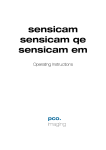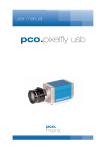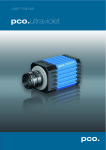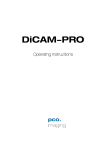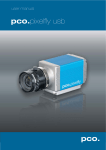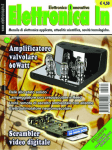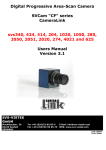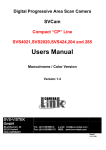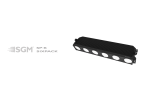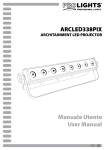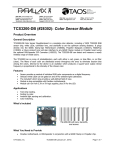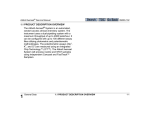Download "user manual"
Transcript
pixelfly pixelfly qe Operating Instructions pco. imaging 3 Safety Instructions Safety Instructions For your own safety and in order to guarantee a safe operation of the camera, please read carefully the following information prior to using the device. • Never operate the camera at places where water or dust might penetrate. • Place the camera on a sufficiently stable basis. Shocks like e.g. dropping the camera onto the floor, might cause serious damage to the device. Therefore exclusively the tripod attachment at the bottom side should be used for mounting the camera. • The camera is not be qualified for X-Ray applications and can be damaged. Our warranty does not cover damaged cameras caused by X-Ray applications. • For applications with laser or plasma light please note that the CCD sensor can be destroyed thermically or physically with too much laser energy. Single pixels or the readout register and therefore the complete sensor can be destroyed. The warranty does not cover damaged sensors by too much laser light / laser energy. • Always unplug the camera before cleaning it. Do not use cleaning liquids or sprays. Instead, use a dry, soft duster. • Never insert any objects through the device's slots. The applied voltage inside the camera can cause short-circuits or electrical shocks. • The slots in the camera housing are needed for ventilation. In order to guarantee a proper operation and to prevent overheating of the camera, these slots must always be kept free. • Make sure that the connecting cable is in good condition and that the link to the socket does not represent an obstacle. • Detach the camera and contact the customer service in the following cases: − When cable or plug are damaged or worn-out. − When water or other liquids have soaked into the device. − When the device is not properly working although you followed all instructions of the user's manual. − When the camera fell to the floor or the housing has been damaged. − When the device shows apparent deviations of normal operation. ©PCO 2006 pixelfly 5 Contents Contents 1. Installation and Powering Up 1.1 Computer ...............................................................................7 System Requirements .............................................................7 Graphic Setup .........................................................................7 Installing the PCI-Board ..........................................................8 1.2 Installation of the Hardware Driver......................................9 Installation under Windows 9x/ME/2000/XP ...........................9 Installation under Windows NT................................................9 Installation under Linux ...........................................................9 1.3 Installation of the Software ‚CamWare’.............................10 1.4 Camera and PCI-Board .......................................................11 Serial Data Transfer ..............................................................11 Lens Mount............................................................................12 Filter Installation ....................................................................12 1.5 Powering Up ........................................................................12 2. Functional Principle 2.1 2.2 2.3 Block Diagram and Internal Data Stream..............................13 Color Definition Algorithm......................................................16 Operating several Cameras from one Computer ..................17 3. Timing 3.1 pixelfly VGA / HiRes / Scientific r.......................................18 Async Mode...........................................................................18 Video Mode ...........................................................................19 DoubleShutter Mode .............................................................20 pixelfly qe .............................................................................21 Async Mode...........................................................................21 Video Modee .........................................................................22 DoubleShutter Mod ...............................................................23 3.2 4. Trigger Control Internal Triggering .................................................................24 External Triggering ................................................................24 LED on the PCI-Board...........................................................25 ©PCO 2006 pixelfly 6 Contents 5. Front-End Processor Front-End Processor .............................................................26 6. Software Application Software CamWare ............................................27 Plug-Ins .................................................................................27 Software Development Kit (SDK) ..........................................27 Drivers ...................................................................................27 7. Servicing, Maintenance and Cleaning Instructions Servicing, Maintenance and Cleaning Instructions ...............28 Cleaning Method for the Optical Part ....................................28 8. Appendix Customer Service..................................................................29 Warranty................................................................................29 CE-Certification .....................................................................29 Dimensions and Weight (VGA, SVGA – long version) ..........30 Dimensions and Weight (QE – long version) ........................32 Dimensions and Weight (VGA, QE – short version)..............34 System Data..........................................................................36 Spectral Response ................................................................37 Operating Instructions pixelfly Version 03/2006 Subject to change without prior notice! Copyright by PCO, 2006 ©PCO 2006 pixelfly 7 1. Installation and Powering Up 1. Installation and Powering Up The pixelfly imaging system consists of camera and PCI-Board. To get the system working properly, follow the instructions. 1.1 Computer System Requirements The PCI-Board should be installed in a computer with following characteristics: • • • • PCI-Bus with PCI-Chip Version 2.1 or higher Intel Processor, Pentium or AMD 128 MB RAM Possible Operating Systems • Microsoft Windows 95 Version 4.00.950b or higher • Microsoft Windows 98 or 98SE • Windows ME • Microsoft Windows NT 4.0 Workstation • Microsoft Windows 2000 Workstation • Microsoft XP • Linux Kernel 2.2, preferable SuSE 6.3 or newer In case of working with Linux, please contact PCO. Graphic Board For best display of images on the monitor we recommend the use of highest performance boards with at least 4MB RAM, preferable with AGP Bus architecture. Graphic Setup The camera generates 12 Bit (4096 grey levels). For display on the PC Monitor 8 Bit (256 grey levels) respectively 3x8 Bit in true color (16,7 millions colors) are generated. In general, several graphic setups are possible. We recommend the setting with 24 or 32 Bit with 16.7 million colors. In the 256-Color-Modus twenty colors are used by Windows for internal purposes. This modus allows to display a maximum of 236 grey levels. Therefore only 7 bit (128 grey levels) are used for black/white display. Some graphic boards use in principle 6 bit for the 256-ColorModus, i. e. not more than 64 grey levels can be displayed on the monitor. ©PCO 2006 pixelfly 8 1. Installation and Powering Up Installing the PCI-Board Caution! Before touching the PCI-Board make sure you have not accumulated static charges. A discharge may destroy the sensitive electronics and voids any guarantee. Insert the PCI-Board in a free PCI-slot of your computer and screw the bow onto the PC housing. Make sure the board does not touch any electrical conducting parts (housing, other boards, wires or chillers) It is essential to use a master PCI-slot. Some computers require additional enabling of PCI-slot mastering on BIOS level. ©PCO 2006 pixelfly 9 1. Installation and Powering Up 1.2 Installation of the Hardware Driver You can operate the camera with Windows9x/ME/2000/NT or Linux. Installation under Windows 9x/ME/2000/XP New-Installation of the hardware driver If you have Windows9x/ME/2000/XP installed, the computer should automatically recognize the new hardware (PCI-Board) and request you to insert a disk with the manufacturer's drivers. For installation please read the actual information in the readme.txt file on the enclosed CD. Updating the hardware driver For updating an existing driver, please download the newest driver version from the internet under http://www.pco.de. For installation please read the actual information in the readme.txt file which will be download automatically with the driver. In case the downloaded drivers are compressed you have to decompress them with a suitable program (e.g. ZIP program). Installation under Windows NT Installation of the Hardware Driver If you install the camera under Windows NT, you need the rights of the administrator. Please login as administrator. For installation please read the actual information in the readme.txt file on the enclosed CD or after downloading from internet. Installation under Linux The Linux driver is on the enclosed CD or can be downloaded from internet under http://www.pco.de. In case the downloaded drivers are compressed you have to decompress them with a suitable program (e.g. ZIP program, TAR program). Detailed instructions for installation you will find in the readme file. ©PCO 2006 pixelfly 10 1. Installation and Powering Up 1.3 Installation of the Software „CamWare“ CamWare is a 32 Bit Windows application. With CamWare all camera parameters can be set. The images can be displayed on the monitor and saved on hard disk. For detailed information please see the separate manual ‚CamWare’. You will find the software CamWare on the enclosed CD. The newest version can also be downloaded from the internet under http://www.pco.de. Installation from CD In case the CD will not start automatically, please start it manually by double click starter.exe. Please select your camera and the software ‘CamWare’: Installation from Internet Download CamWare from the Internet to a free selected directory. The downloaded file must be decompressed with a suitable program (e.g. ZIP program) Start the installation with setup.exe. The newest information how to install CamWare can be found in the readme.txt file. To install CamWare under Windows 2000, Windows NT or Windows XP you need administration rights. Remark After successful installation the computer has to be restarted. The installation program transfers all necessary DLL and OLE files to the respective Windows, checking automatically for existing older versions and replacing them by new ones. Windows’95 carries out all „registry“-entries. If the program is to be deleted from the computer, a proper deinstallation is carried out in START - SETUP - SYSTEM CONTROL - SOFTWARE After successful installation you will have the new directory ‘Digital Camera Toolbox’. CamWare and some additional useful tools will be installed to this directory. Hotline ©PCO 2006 pixelfly In case you have problems during installation, call our hotline (see „Customer Service“). 11 1. Installation and Powering Up 1.4 Camera and PCI-Board Before Powering Up, make the connection between camera head and PCI-Board. In case of not using the enclosed cable, please note: • Pleas use only Ethernet cables, where all 8 lines are connected (4x twisted pair). • The cable quality must be at least category 5, 5+ or higher • minimum cable length: 2m • maximum cable length: 12.5m Remark The connectors and cable are identical with Ethernet cables but there is no Ethernet protocol! Standard and Compact PCI-Board The front plates and connectors of the Standard and Compact PCI-Boards are identical. Frontplatten und Steckeranordnungen. Interface 2 is the connection between camera head and PCIBoard. The camera can be controlled via Interface 1 (e.g. external triggering, Front-End Processor, ...) The LEDs show the operating states as follows: LED 1 (green) LED 1 (red) LED 2 (green) LED 2 (red) ©PCO 2006 pixelfly control display when connection between camera head and PCI-Board is ok control display at data transfer Power-On (blinking) control display at external trigger input 12 Lens Mount 1. Installation and Powering Up pixelfly has a standard C-Mount with a back focal length of 17.52mm (Distance between front edge of C-Mount and CCDsensor). Standard C-Mount lenses or other lenses with their respective C-Mount adapter (e.g. photo camera lenses) can be used. The maximum screw-in depth of a lens (or adapter) is 9.5mm. Deeper screwing in could destroy the protecting window of the camera (no warranty!). The VGA and HiRes sensors have a 1/2“ format, the SVGA and QE sensors a 2/3“. We recommend to use for all pixelfly Versions a 2/3“ or 1“ compatible lens. Cameras with high resolution sensor should preferably be equipped with a high quality lens to take advantage of the high resolution. The cameras can be equipped optionally with a filter. This filter will be placed at the C-Mount ring. In this case the maximum screw-in depth is only 6mm instead of the 9.5mm. Insert Filters Filters can be set in front of the CCD. You have to use a 24 mm diameter filter. In the C-mount screw there is a ring which can be screwed out. Now the filter can be placed and the ring must be screwed in again. 1.5 Powering Up Check the following points: • PCI-Board properly mounted • Connection between camera and PCI-Board • Lens mounted Now start the program „CamWare“ from the directory Programme – Digital Camera ToolBox. For detailed information to CamWare please see the separate manual ‚CamWare’. ©PCO 2006 pixelfly 13 2. Functional Principle 2. Functional Principle The images, captured by the camera head, will be transferred via a high speed data transfer to the PCI-Board in the computer. The data will be saved in the RAM of the computer where the operator can decide what to do with them. With the enclosed software ‚CamWare’ the camera can be controlled within the windows environment and the images can be displayed on the monitor. The Recorder function allows you to record image sequences and display them as "movies". The maximum memory space for the recorded images depends solely on the RAM size of your computer. When starting the program, the software automatically recognizes the camera type. For detailed information to CamWare please see the separate manual ‚CamWare’. 2.1 Block Diagram and Data Stream Block Diagram In the following block diagram the structure of the complete camera system is shown. Lens CCD High speed data transfer CCD Head PCI-Interface-Board External Trigger Input ©PCO 2006 pixelfly 14 2. Functional Principle Internal Data Stream of black/white cameras The PCI-Board gets the 12bit data from the camera and transfers it via PCI-Bus to a 16bit array (of the PC Memory). The higher 4bits are set to zero. The 16bit data are automatically converted in a 8bit array and accessed by the graphic board. Depending on graphic board setup display on the monitor is effected in 8, 24 or 32 bit. File Formats The command ‘Export’ stores 16bit or 8bit data on hard disk in B16, TIFF, FITS, BMP, or ASCII format. For further information see Chapter 2.3. Display The camera which acquires always 12 bit images resolves with 4096 (2E12) grey levels between black and white, however the monitor display of the image is always limited to 8 bit and therefore to 256 (2E8) grey levels. The command ‘Convert Control’ allows to select a discretionary range between 0 ... 4095 grey levels which is then displayed in 256 grey levels on the PC monitor. PC Monitor Camera PCI-Interface-Board Graphic Board PCI-Bus ©PCO 2006 pixelfly 15 2. Functional Principle Internal Data Stream of color cameras The PCI-Board gets the 12bit data from the camera and transfers it via PCI-Bus to a 16bit array (of the PC memory). The higher 4bits are set to zero. The 16 bit data are converted automatically into a 3 x 8 bit array and accessed by the graphic board. We recommend to display it in 32bits on the monitor. File Formats The command ‘Export’ stores 16bit or 8bit data on hard disk in B16, TIFF, FITS, BMP, or ASCII format. For further information see Chapter 2.3. Display The camera which acquires always 12 bit images resolves with 4096 (2E12) grey levels between black and white, however the monitor display of the image is always limited to 8 bit and therefore to 256 (2E8) grey levels. The command ‘Convert Control’ allows to select a discretionary range between 0 ... 4095 grey levels which is then displayed in 256 grey levels on the PC monitor. PC Monitor Camera PCI-Interface-Board Graphic Board PCI-Bus ©PCO 2006 pixelfly 16 2. Functional Principle 2.2 Color Definition Algorithm Color sensors with RGB filter for the colors red, green and blue are used for the color cameras. The CCD sensor records for each pixel the light information as grey level with 12 Bit dynamic (RX, GX, BX). With the help of the camera control software, for each pixel the 12 Bit data is converted by interpolating into a 8 Bit triplet (PRED, PGREEN, PBLUE). For this interpolation following algorithm is applied: Algorithm 1 This algorithm optimises the color resolution. A red, green and blue part of the color for virtual pixels will be calculated. These virtual pixels are placed between the original pixels. In CamWare this algorithm is also called as ‘Smooth’. • The first pixel on the top left side is always "red". • Between the physical pixels, there are virtual pixels PX which are computed with the algorithm described below. Physical Pixel R1 G2 R3 G4 G5 B6 G7 B8 R9 PX G10 R11 G12 G13 B14 B16 G15 ... Virtual Pixel ... Conversion algorithm for the new pixel PX: PRED = ( 9 R11 + 3 R3 + 3 R9 + R1 )/16 PGREEN = ( G7 + G10 )/2 PBLUE = ( 9 B6 + 3 B8 + 3 B14 + B16 )/16 Algorithm 2 This algorithm optimises the spatial resolution. For each physical pixel, a color value (red, green and blue) is calculated, related to the corresponding neighbour pixel. Example for Pixel6 PRED = ( R1 + R3 + R9 + R11 )/4 PGREEN = ( G2 + G5 + G7 + G10 )/4 PBLUE = B6 Example for Pixel7 PRED = ( R3 + R11 )/2 PGREEN = G7 PBLUE = ( B6 + B8 )/2 ©PCO 2006 pixelfly 17 2. Functional Principle 2.3 Operating several Cameras from one Computer Depending of the computer specification up to four cameras can be used in one computer at the same time. On the PCI-Board there is a FIFO memory (no full frame memory!). The incoming data must be transferred in real time to the computer RAM. With the 16 MHz versions (VGA 640 x 480 pixel and HiRes 1360 x 1024) the data transfer is 32 MB/s. For two cameras in one computer you have 64 MB/s. With the 20 MHz version (Scientific 1280 x 1024 pixel and QE 1392 x 1024) the data transfer is 40 MB/s, with two cameras 80 MB/s. Please note that with synchronous triggering, maximum two VGA cameras can be used. Cameras with higher resolution (pixelfly Scientific, HiRes, qe) can cause conflicts. The advantage of the FIFO memory (compared with a full frame memory) is that you have no additional delay. The disadvantage, that only two PCI-Boards can be used in one computer at the same time, can be avoided by using CompactPCI CPUs in several computers which are connected by 100 MBit Ethernet cable. ©PCO 2006 pixelfly 18 3. Timing 3. Timing 3.1 pixelfly VGA / HiRes / Scientific The pixelfly timing depends of the exposure mode Async-, Video- and DoubleShutter modes are available. Async Mode Each trigger (internal or external) generates an image. The following signals /BUSY, /CCD-Exposure and /CCDReadout are at the 26-pin. HD-DSUB socket of the PCI-Board. External Trigger / BUSY / CCD-Exposure / CCD-Readout Internal Delay tdi texp tj1 tj2 Exposure Time CCD Readout Time timing not scaled 10...20µs 5µs...65ms 0...5µs 300...700µs Example for a external triggered sequence / BUSY / CCD-Exposure / CCD-Readout CCD Readout Time The CCD readout time depends of the CCD sensor (VGA, Scientifi, HiRes or UV) and of the selected binning: VGA (200/205) VGA (210/215) Scientific HiRes / UV ©PCO 2006 pixelfly V1-Binning: V2-Binning V4-Binning V1-Binning: V2-Binning V4-Binning V1-Binning V2-Binning V1-Binning V2-Binning 19,8ms ± 0,5 10,3ms ± 0,5 5,6ms ± 0,5 24,8ms ± 0,5 12,8ms ± 0,5 6,8ms ± 0,5 79,8ms ± 0,5 40,3ms ± 0,5 104,0ms ± 0,5 52,5ms ± 0,5 19 3. Timing Video Mode A trigger generates a complete imaging sequence. The following signals /BUSY, /CCD-Exposure and /CCDReadout are at the 26-pin. HD-DSUB socket of the PCI-Board. External Trigger / BUSY / CCD-Exposure / CCD-Readout Intrinsic + System Delay Exposure Time < Readout Time BUSY CCD-Exposure CCD-Readout Exposure Time > Readout Time BUSY CCD-Exposure CCD-Readout CCD Readout Time The CCD readout time depends of the CCD sensor (VGA, Scientifi, HiRes or UV) and of the selected binning: VGA (200/205) VGA (210/215) Scientific HiRes / UV ©PCO 2006 pixelfly V1-Binning: V2-Binning V4-Binning V1-Binning: V2-Binning V4-Binning V1-Binning V2-Binning V1-Binning V2-Binning 19,8ms ± 0,5 10,3ms ± 0,5 5,6ms ± 0,5 24,8ms ± 0,5 12,8ms ± 0,5 6,8ms ± 0,5 79,8ms ± 0,5 40,3ms ± 0,5 104,0ms ± 0,5 52,5ms ± 0,5 20 3. Timing DoubleShutter Mode (only XD-Version) Two separated full frame images with a short interframing time can be captured. The length of the first exposure time will be done by software input, the triggering either internally by software or by an external trigger signal. The exposure time of the second image corresponds to the readout time of the first image. It depends of the used CCD sensor and binning mode. During the interframing time td (dead time) no exposure should be done The following signals /BUSY, /CCD-Exposure and /CCDReadout are at the 26-pin. HD-DSUB socket of the PCI-Board. External Trigger / BUSY / CCD-Exposure / CCD-Readout Internal Delay Exposure Image 1 Exposure Image 2 Readout Time 1 Real exposure on CCD sensor tdi texp1 tj1 tj2 tj3 td Image 1 Readout Time 2 Image 2 10...20µs 5µs...65ms 0...5µs 300...700µs 0...3µs 2µs timing not scaled texp1 can be set to 10µs...10ms by software. exposure time of image 2 (texp2) = readout time of image 1 Example To set two laser pulses in a short time one after another (about 10µs), the following relation is valid. The timing of the first laser pulse starts with the falling edge of /BUSY (respect. /CCDExposure). The first laser pulse must be set at the end of image 1, the second laser pulse at the beginning of image 2. 1. laser pulse = texp1 – tj1 2. laser pulse = 1. laser pulse + tj1 + (td + tj3 ) CCD Readout Time The CCD readout time depends of the CCD sensor (VGA, Scientifi, HiRes or UV) and of the selected binning: VGA (200/205) VGA (210/215) Scientific HiRes / UV ©PCO 2006 pixelfly V1-Binning: V2-Binning V4-Binning V1-Binning: V2-Binning V4-Binning V1-Binning V2-Binning V1-Binning V2-Binning 19,8ms ± 0,5 10,3ms ± 0,5 5,6ms ± 0,5 24,8ms ± 0,5 12,8ms ± 0,5 6,8ms ± 0,5 79,8ms ± 0,5 40,3ms ± 0,5 104,0ms ± 0,5 52,5ms ± 0,5 21 3. Timing 3.2 pixelfly qe The pixelfly timing depends of the exposure mode. Async-, Video- and DoubleShutter modes are available. Async Mode Each trigger (internal or external) generates an image. The following signals /BUSY, /CCD-Exposure and /CCDReadout are at the 26-pin. HD-DSUB socket of the PCI-Board. External Trigger / BUSY / CCD-Exposure / CCD-Readout Internal Delay tdi texp tj1 tj2 Exposure Time CCD Readout Time timing not scaled 10...20µs 5µs...65ms 0...5µs 300...700µs Example for a external triggered sequence / BUSY / CCD-Exposure / CCD-Readout CCD Readout Time The CCD readout time depends of the CCD sensor and of the selected binning: pixelfly qe ©PCO 2006 pixelfly V1-Binning V2-Binning 88,3ms ± 0,5 44,8ms ± 0,5 22 3. Timing Video Mode A trigger generates a complete imaging sequence. The following signals /BUSY, /CCD-Exposure and /CCDReadout are at the 26-pin. HD-DSUB socket of the PCI-Board. External Trigger / BUSY / CCD-Exposure / CCD-Readout Intrinsic + System Delay Exposure Time < Readout Time BUSY CCD-Exposure CCD-Readout Exposure Time > Readout Time BUSY CCD-Exposure CCD-Readout CCD Readout Time The CCD readout time depends of the CCD sensor and of the selected binning: pixelfly qe ©PCO 2006 pixelfly V1-Binning V2-Binning 88,3ms ± 0,5 44,8ms ± 0,5 23 3. Timing DoubleShutter Mode (only XD-Version) Two separated full frame images with a short interframing time can be captured. The length of the first exposure time will be done by software input, the triggering either internally by software or by an external trigger signal. The exposure time of the second image corresponds to the readout time of the first image. It depends of the used CCD sensor and binning mode. During the interframing time td (dead time) no exposure should be done The following signals /BUSY, /CCD-Exposure and /CCDReadout are at the 26-pin. HD-DSUB socket of the PCI-Board. External Trigger / BUSY / CCD-Exposure / CCD-Readout Internal Delay Exposure Image 1 Exposure Image 2 Readout Time 1 Real exposure on CCD sensor tdi texp1 tj1 tj2 tj3 td Image 1 Readout Time 2 Image 2 10...20µs 5µs...65ms 0...5µs 300...700µs 0...3µs 2µs timing not scaled texp1 can be set to 10µs...10ms by software. exposure time of image 2 (texp2) = readout time of image 1 Example To set two laser pulses in a short time one after another (about 10µs), the following relation is valid. The timing of the first laser pulse starts with the falling edge of /BUSY (respect. /CCDExposure). The first laser pulse must be set at the end of image 1, the second laser pulse at the beginning of image 2. 1. laser pulse = texp1 – tj1 2. laser pulse = 1. laser pulse + tj1 + (td + tj3 ) CCD Readout Time The CCD readout time depends of the CCD sensor and of the selected binning: pixelfly qe ©PCO 2006 pixelfly V1-Binning V2-Binning 88,3ms ± 0,5 44,8ms ± 0,5 24 4. Trigger Control 4. Trigger Control The pixelfly can be triggered via the 26-pin. HD-DSUB socket at the PCI-Board. Additional control signals are available. The trigger control is generated by the Front-End-Processor ORION (see chapter 5). Pinning of the 26-pin. HD-DSUB socket at the PCI-Board: Pin Name at Name at Function DSUB ORION 1 OPTO IN 6 PD3 Trigger Input * 2 OPTO IN 5 PD2 ** 3 OPTO IN 4 PB3 ** 4 OPTO IN 3 PB2 ** 5 OPTO IN 2 PB1 ** 6 OPTO IN 1 PB0 ** 7 HighSide 204 PC3 HighSide Driver 8 HighSide 104 PC7 HighSide Driver 9 HighSide 103 PC6 HighSide Driver 10 GND Ground for output signals 11 n.c. 12 OPTO GND Trigger Ground 13 do not use 14 do not use 15 GND Ground for output signals 16 HighSide 202 PC1 HighSide Driver 17 HSSUP. Power Input for HighSide Driver 18 HighSide 102 PC5 HighSide Driver 19 I/O1 PD5 Blink Output (LED green) 20 I/O2 PD4 CCD Busy Output (LED red) 21 I/O3 PD0 CCD Exposure Output 22 I/O4 PD1 CCD Readout Output 23 HighSide 203 PC2 HighSide Driver 24 HighSide 201 PC0 HighSide Driver 25 GND Ground for output signals 26 HighSide 101 PC4 HighSide Driver * Input Voltage according to the sticker on the PCI board ** 24V Input Voltage Timing diagram of the three CCD signals (low level logic) /CCD busy /CCD exp /CCD readout Trigger Input Input, high active A rising edge (TTL signal, 5V) starts a new exposure. Pin 1 R 111 + Trigger 10K - ©PCO 2006 pixelfly Pin 12 HCPL-0661 25 4. Trigger Control Trigger Input Voltages The trigger input voltage can be changed to +12V or +24V. For details see Technical Manual of the pixelfly available at PCO on request. min. Input 24V 10 V Input 12V 6V Input 5V* 3V * Factory preset. typ. 24 V 12 V 5V max. 40 V 24 V 8V R 111 3.3 kOhm 1.5 kOhm 520 Ohm Busy Output (LED) Output (low active) and red LED (parallel) Output to low from staring the trigger till end of CCD readout Blink LED Blinking LED (about 8 Hz) as power-on control. CCD Exposure Output Output, low active While exposing, this signal will be active low. CCD Readout Output ©PCO 2006 pixelfly Output, low active While reading out the CCD, this signal is low. 26 5. Front-End Processor 5. Front-End Processor A Front-End processor (ORION) is placed on the PCI-Board. This processor can be programmed by the end-user himself. The external trigger input and some control signals will be handled by the processor. This I/O controller can be used for individual tasks (e.g. microscopy control, error control, …). To input signals there are optionally 8 high-side drivers available which can be controlled with maximum 1A each. These drivers are short-circuit protected and therefore useful for industrial applications. Furthermore there are three double opto-coupler available (Galvanic separated). The Assembler Source Code of the ORION processor can be found on the PCO Utility CD (ORION201.ASM, 8515DEF.INC). An executable code (Intel-Hex) can be downloaded via the PCI interface by a programming software (see SDK directory). ©PCO 2006 pixelfly 27 6. Software 6. Software Application Software Shipment of the camera system includes the CamWare software, a complete operation software for the camera allowing to display and to save images. For detailed information to CamWare please see the separate manual ‚CamWare’. Plug-Ins n case you are already working with an image processing or image analysis software appropriate Plug-Ins may be installed. Consequently camera control commands can be sent directly from the image analysis software. You will find more information about Plug-Ins on our website. In case your software is not listed above, please contact PCO. Software Development Kit In case you have written your own software or you wish to include the control software into already existing programs, the camera control may be integrated as DLL file by using our Software Development Kit (SDK). The following SDK’s with detailed manual are available: • SDK for Windows 9x/ME/2000/NT • SDK for Linux The SDK can be found on the CD or can be downloaded from Internet under http://www.pco.de. Drivers To work with the camera properly a Twain driver and the following PCI-Board drivers are available: • PCI-Board driver for Windows 9x/ME/2000/XP • PCI-Board driver for Windows NT • PCI-Board driver for Linux The drivers can be found on the CD or can be downloaded from Internet under http://www.pco.de. ©PCO 2006 pixelfly 28 7. Servicing, Maintenance and Cleaning Instructions 7. Servicing, Maintenance and Cleaning Instructions Servicing, Maintenance and Cleaning Instructions The camera is maintenance-free. Factory settings make any inspection and servicing superfluous. During use the camera should be protected from hard shocks or strong vibrations. Also should the camera be protected from high humidity and temperature shocks. Avoid exposing to sunlight, since it heats up the camera housing unnecessarily and prevents the cooling from reaching its optimum operating temperature. Keep apertures and slots free to allow air to circulate. Objective lens or lens adapter should be screwed in gently. Avoid forcing as it will damage the tread. Use a soft and dry cloth to clean the housing. Cleaning Method for the Optical Part In principle every cleaning method bears the danger of damaging an optical surface. Therefore clean only if it is strictly necessary. As a first step use dry air to blow out dust particles. Avoid strictly to wipe on a dry glass surface. In case dirt cannot be removed by blowing, use special optical cleaning fluids. Adequate fluids for optical surfaces are: pure dehydrogenated alcohol, pure acetone or cleaning fluids available in photo shops. Use a soaked cotton tip and take care to wipe only on glass surfaces, avoiding contact to metal surfaces, e.g. C-Mount thread, otherwise microscopic dirt and metallic chips are released, causing irreparable scratches on the glass surface. Never use aggressive cleaning substances, e.g. benzine, spirit, nitro solvents, etc. commonly found in labs. Such substances may destroy or damage the surface on which they are applied. Hint The best is to avoid any dirt on optical parts, e.g. by replacing immediately the black protection cap when removing the objective lens. Do not leave the camera’s optical input window open, without lens or protecting cap. Our warranty does not cover damaged optical surfaces caused by improper cleaning methods. ©PCO 2006 pixelfly 29 8. Appendix 8. Appendix Customer Service Having a problem or a question about matters not handled in these operating Instructions, we recommend to contact us : ... by Telephone ... by Fax ... by Email ... by Post 09441/2005-0 09441/2005-20 [email protected] PCO AG Donaupark 11 D-93309 Kelheim Germany • • • • • • Serial number of the camera head Serial number of the PCI-Board Detailed description of the problem Experiment conditions Settings in the camera control software Technical data of the computer Warranty PCO grants a warranty by law for the pixelfly System (camera, PCI-Board, FOL or coaxial cable, power supply). The warranty period starts on day of delivery ex-factory. In case of defect within the warranty period replacement or repair will be made (at PCO’s discretion) free of charge. The device shall be returned on customer’s expenses to PCO, preferably in the original package. PCO is not liable for consequential damages. Before returning the camera, contact PCO via any of the Customer Services. Pay attention to use a sufficient package if you have to send the camera via mail (keep the original package). The FOL cable connectors and the connectors of the camera and PCI-Board must be protected with the protection caps. Don’t forget to screw the C-Mount protection cap! Attention Opening of the camera or improper handling (e.g. damage by electrostatic charge, wrong cleaning method) voids the warranty. CE-Certification pixelfly complies with the requirements of the „EMC Directions of the European Communities (089 / 336 / EWG)“ and therefore bears the CE-Marking. ©PCO 2006 pixelfly 30 8. Appendix Dimensions and Weight pixelfly cameras are available in different housings. Please select the right version! VGA, HiRes and Scientific versions (long housing) Lateral view Top view Front View ©PCO 2006 pixelfly 31 8. Appendix Rear View Top View (bottom view incl. tripod) Weight of the Camera Head: about 270g ©PCO 2006 pixelfly 32 8. Appendix QE versions (long housing) Lateral View Top View Front View ©PCO 2006 pixelfly 33 8. Appendix Rear View Top View (bottom view incl. tripod) Weight of the Camera Head: about 290g ©PCO 2006 pixelfly 34 8. Appendix VGA versions (short housing) QE versions (short housing) Lateral View Top View Front View ©PCO 2006 pixelfly 35 8. Appendix Rear View Top View (bottom view incl. tripod) Weight of the Camera Head: about 280g ©PCO 2006 pixelfly 36 8. Appendix System Data CCD Sensor Number of Pixels Pixel Size Sensor Format Scan Area Full Well Capacity Readout Noise Scan Rate Imaging Frequency … … at binning mode 1 … at binning mode 2 … at binning mode 4 A/D Conversion Factor Spectral Range b/w Spectral Range color Anti Blooming CCD Quality Non-Linearity (Differential) Binning Vertical Binning Horizontal VGA (200 / 205) 640 (H) x 480 (V) 9.9µm x 9.9µm 1/2“ 6.3 x 4.8 mm 30.000 e11…14 e20 MHz VGA (210 / 215) 640 (H) x 480 (V) 9.9µm x 9.9µm 1/2“ 6.3 x 4.8 mm 30.000 e16 e16 MHz Scientific (230 / 235) 1280 (H) x 1024 (V) 6.7µm x 6.7µm 2/3“ 8.6 x 6.9 mm 20.000 e12 e20 MHz 50 fps 95 fps 177 fps 6.5 e-/count 290 ... 1000 nm primary color, RGB > 1000 grade 0 < 2% factor 1, 2, 4 factor 1, 2 40 fps 76 fps 140 fps 7 e-/count 290 ... 1000 nm primary color, RGB > 1000 grade 0 < 2% factor 1, 2, 4 factor 1, 2 12,5 fps 24 fps not available 4,5 e-/count 290 ... 1000 nm primary color, RGB > 1000 grade 0 < 2% factor 1, 2 factor 1, 2 CCD Sensor Number of Pixels Pixel Size Sensor Format Scan Area Full Well Capacity Readout Noise Scan Rate Imaging Frequency … … at binning mode 1 … at binning mode 2 … at binning mode 4 A/D Conversion Factor Spectral Range b/w Spectral Range color Anti Blooming CCD Quality Non-Linearity (Differential) Binning Vertical Binning Horizontal HiRes (220 / 225) 1360 (H) x 1024 (V) 4.65µm x 4.65µm 1/2“ 6.3 x 4.7 mm 13.000 e6…9 e16 MHz QE (270 / 275) 1392 (H) x 1024 (V) 6.45µm x 6.45µm 2/3“ 9.0 x 6.6 mm 18.000 e6…9 e20MHz 9,5 fps 18 fps not available 3 e-/count 290 ... 1000 nm primary color, RGB > 1000 grade 0 < 2% factor 1, 2 factor 1, 2 12 fps 23 fps not available 3.8 e-/count 290 ... 1000 nm primary color, RGB > 400 grade 0 < 2% factor 1, 2 factor 1, 2 Camera Head + PCI-Board Power consumption PCI-Board Camera Head 1 A at 5 V, 400mA at 12 V about 10 W about 2,6 W …3,3 W ©PCO 2006 pixelfly 37 8. Appendix Spectrale Response (typical values) pixelfly VGA pixelfly Scientific pixelfly HiRes Scientific HiRes VGA ©PCO 2006 pixelfly 38 8. Appendix pixelfly qe low light mode (= gain high) standard mode (= gain normal) ©PCO 2006 pixelfly Dear Customer, We hope this camera will be an always valuable tool for your scientific day in, day out work. Comments, suggestions or any new idea on our system are welcome. We are at your disposal at any time, also after your buying of this camera. Your PCO Team pco. imaging PCO AG Donaupark 11 D-93309 Kelheim fon: +49 (0)9441 2005 0 fax: +49 (0)9441 2005 20 eMail: [email protected] www.pco.de








































